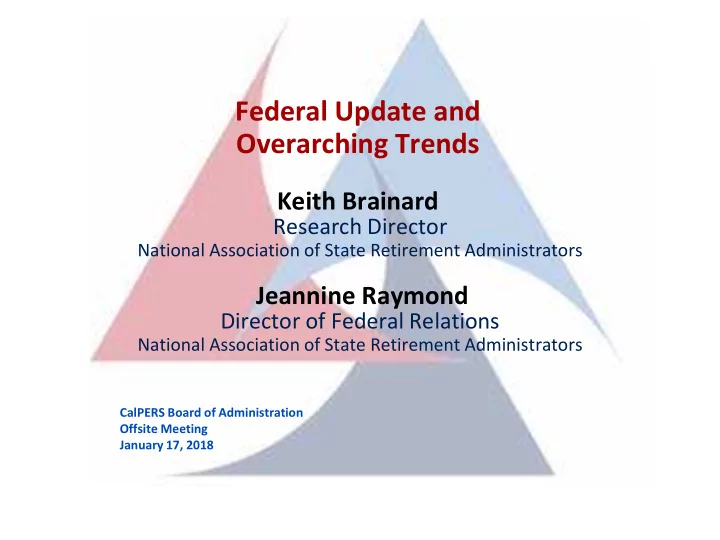

Federal Update and Overarching Trends Keith Brainard Research Director National Association of State Retirement Administrators Jeannine Raymond Director of Federal Relations National Association of State Retirement Administrators CalPERS Board of Administration Offsite Meeting January 17, 2018
Factors Driving Public Pension Changes Factors Changes Higher unfunded pension Sub-par investment returns liabilities Sustained low interest rates Increased plan costs Lower projected investment returns More conservative actuarial assumptions and Maturing public sector methods workforce Lower benefit levels Plan sponsor fiscal constraints Shifting risk from employers to employees 2
Comparison of Retirement Benefits in the U.S. Private Sector Public Sector Nearly all full-time workers have 60% of full-time private sector workers access to an employer-sponsored participate in an employer-sponsored retirement benefit; most have retirement plan; 21% of part-time access to a traditional pension (DB workers participate plan) In total, 49% of all private sector 87% of full-time employees workers participate in an employer- participate in a pension plan; virtually all others are in a DC plan sponsored retirement plan Three-fourths participate in Social Fewer than one in five have a Security traditional pension (DB) plan Social Security coverage is universal 3
Median annualized public pension fund returns for periods ended 6/30/17
Wilshire 10-Year Projected Returns
Change in employment, private sector and state and local government, FY07- FY17 US Bureau of Labor Statistics, compiled by NASRA
Median change in number of actives and annuitants, FY 01 to FY 16
Annual change in wages and salaries, private sector and state and local government, 2001-2017 US Bureau of Labor Statistics, compiled by NASRA
Median change from prior year in actuarial value of assets and liabilities FY02-FY16
Change in use of amortization methods Public Plan Database, Public Fund Survey
Change in average amortization period and plans using closed amortization Public Plan Database, Public Fund Survey
Change in distribution of nominal investment return assumptions, FY 01 to FY 18
States that reduced automatic COLAs 13 “Significant Reforms to State Retirement Systems,” NASRA 2016
Statewide Hybrid Plans, 2017 “State Hybrid Retirement Plans,” NASRA 2016
Statewide Defined Contribution Plans In Place for Broad Employee Groups * Mandatory Optional Arizona District of Columbia, for general employees Colorado Michigan, for state Florida employees hired since Indiana 3/1/97 Montana Alaska, for all public employees hired since Ohio 7/1/06 South Carolina Oklahoma, for state Utah employees hired since 11/1/15 15 *General employees, teachers, or public safety personnel
Final Thoughts Following a long period of improving funding conditions and expanding benefit levels, public pension funding and benefit levels have been declining for 15 years. Most states have retained core elements of traditional retirement plan design — sharing of benefit costs between employees and employers, pooled assets and liabilities, and annuitized benefits. More conservative actuarial assumptions and methods are driving costs higher. Changes to plan designs focus on lower benefit levels and shifting risk from employers to employees. For political and legal reasons, the type and extent of changes to plan designs varies among states.
Evolving NASRA Federal Relations Congress and the Administration ▲ Less advocating for changes to federal laws and regulations and more defending against them ▲ More/renewed concern about federal role State/Local Government Associations and Employee Organizations ▲ Coming together on advocacy and a common set of facts Private Sector Retirement Groups and Employee Organizations ▲ Building understanding, support &/or lessening muddling of issues Policy Organizations, Think Tanks, Academics ▲ Education, redirection and/or opposition
Pension Tax Provisions in Play Limits “Rothification” Combining 457/403(b)/401(k) into one Eliminating “special” rules for governmental 457 plans Changing tax treatment of employee contributions to state/local DB plans Min. age for in-service distributions Unrelated Bus. Income Tax (UBIT)
Additional Retirement Tax Proposals Public Employee Pension Transparency Act (PEPTA) ▲ Costly/conflicting federal reporting requirements; severe penalties on sponsors for non-compliance Secure Annuities for Employee (SAFE) Retirement Act ▲ Title 1 – Private insurance annuity vehicle to replace state/local DB plans Retirement Enhancement Security Act (RESA) ▲ Unanimously approved out of Senate Finance Committee ▲ No adverse provisions for public plans
Muddling of Public and Multiemployer DB Plan Issues Continued conflation of state/local plans and multiemployer plans (particularly Central States Pension Fund) Efforts to move mine worker pension legislation and pension loan proposals spur “bailout” concerns Backlash to cuts approved under the Multiemployer Pension Reform Act (MPRA) Confusion over fact that MPRA is not applicable to state/local plans
Continued Interest by Market Regulators Securities and Exchange Commission enforcement unit on Municipal Finance and Public Pensions Municipal Securities Rulemaking Board expanded jurisdiction Financial Stability Oversight Council (FSOC) monitoring of markets and state/local economies Treasury Office of State and Local Finance
Renewed Efforts on Intergovernmental Relations?
Strong, United Opposition to Federal Intervention
Opposition, cont. Unhelpful ▲ Does NOT lower costs, protect benefits or improve pension financing ▲ Public plan issues are not systemic; differing fiscal and legal frameworks defy a one-size-fits-all solution Unwarranted ▲ Significant reforms have been enacted across the country ▲ New GASB reporting standards in effect ▲ Information is public ▲ Online database already exists
Public Information & Disclosures
Getting the Facts
Recommend
More recommend